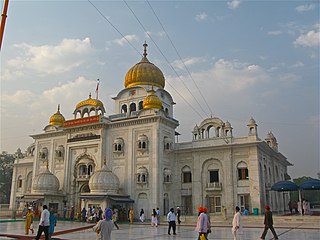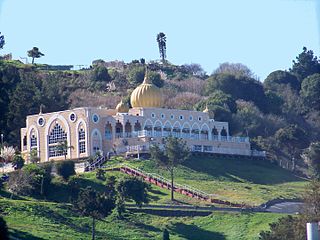
A gurdwara or gurudwara is a place of assembly and worship for Sikhs. Sikhs also refer to gurdwaras as Gurdwara Sahib. People from all faiths and religions are welcomed in gurdwaras. Each gurdwara has a Darbar Sahib where the Guru Granth Sahib is placed on a takht in a prominent central position. Any congregant may recite, sing, and explain the verses from the Guru Granth Sahib, in the presence of the rest of the congregation.

East Side San Jose, commonly called The East Side and less commonly as the East Valley, is the eastern region of the city of San Jose, California. The East Side is made up of numerous neighborhoods grouped into two larger districts: Alum Rock and Evergreen. East San Jose is bordered by the Diablo Range to the east and south, the Coyote Creek to the west, and Mabury Road to the North.

Vaisakhi, also pronounced Baisakhi as well as Basoa, marks the first day of the month of Vaisakh and is traditionally celebrated annually on 13 April and sometimes 14 April. It is seen as a spring harvest celebration primarily in Punjab and Northern India. Further, other Indian cultures and diaspora celebrate this festival too. Whilst it is culturally significant as a festival of harvest, in many parts of India, Vaisakhi is also the date for the Indian Solar New Year.

The Shiromani Gurdwara Parbandhak Committee is an organization in India responsible for the management of Gurdwaras, Sikh places of worship in states of Punjab and Himachal Pradesh and the union territory of Chandigarh. SGPC also administers Darbar Sahib in Amritsar.

Gurdwara Bangla Sahib is one of the most prominent Sikh gurdwaras, or Sikh house of worship, in Delhi, India, and known for its association with the eighth Sikh Guru, Guru Har Krishan, as well as the holy pond inside its complex, known as the "Sarovar." It was first built as a small shrine by Sikh General Sardar Baghel Singh in 1783, on the bungalow donated by king Raja Jai Singh of Amer, who supervised the construction of nine Sikh shrines in Delhi in the same year, during the reign of Mughal Emperor, Shah Alam II.

Anandpur Sahib, also referred simply as Anandpur, is a city in Rupnagar district (Ropar), on the edge of Shivalik Hills, in the Indian state of Punjab. Located near the Sutlej River, the city is one of the most sacred religious places in Sikhism, being the place where the last two Sikh Gurus, Guru Tegh Bahadur and Guru Gobind Singh, lived. It is also the place where Guru Gobind Singh founded the Khalsa Panth in 1699. The city is home to Takhat Sri Kesgarh Sahib, the third of the five Takhts in Sikhism.

Westfield Valley Fair, commonly known as Valley Fair, is a prominent shopping mall in San Jose, California. Valley Fair is the largest mall, by area, in Northern California and has higher sales revenue than all other malls in California, including the two in Southern California which have larger area than Valley Fair. Valley Fair is the thirteenth largest shopping mall in the United States. It is located on Stevens Creek Boulevard in West San Jose. The mall features Macy's, Macy's Men's and Home Store, Nordstrom and Bloomingdale's.

Sikh architecture is a style of architecture that was developed under the Sikh Confederacy and Sikh Empire during the 18th and 19th centuries in the Punjab region. Due to its progressive style, it is constantly evolving into many newly developing branches with new contemporary styles. Although Sikh architecture was initially developed within Sikhism its style has been used in many non-religious buildings due to its beauty. 300 years ago, Sikh architecture was distinguished for its many curves and straight lines; Keshgarh Sahib and the Harmandir Sahib are prime examples.

The Sikh Center of San Francisco Bay Area is a Sikh gurdwara in the hills of unincorporated El Sobrante, California, in the East Bay of the San Francisco Bay Area.
Gurdwara Sahib Klang is a Sikh gurdwara located in the town of Klang in Selangor, Malaysia. It was constructed between November 1993 and late 1995. The total cost of the building was nearly RM 2,000,000 and out of which RM 100,000 was donated by the Prime Minister's Department. Donations were received from the Sikh Sangat from all over Malaysia to complete this project.

The Shri Swami Narayan Mandir, Karachi is a Hindu temple that is the only Swami Narayan temple in Pakistan. The temple is notable for its size and frontage, over 32,306 square yards (27,012 m2) on the M. A. Jinnah Road in Karachi city. The temple celebrated its anniversary of 216 years in April 2004. There is a sacred cowshed within the premises of this temple. The temple is located at the centre of a Hindu neighbourhood in Karachi. The building that housed a dharmshala for visiting devotees has now been converted to the office of the City District Government.

English Sikhs number over 520,000 people and account for 0.92% of England's population in 2021, forming the country's fourth-largest religious group. In 2006 there were 352 gurdwaras in England. The largest Sikh populations in the U.K. are in the West Midlands and Greater London.

Gurdwara Darbar Sahib Kartarpur, also called Kartarpur Sahib, is a gurdwara in Kartarpur, located in Shakargarh, Narowal District, in the Punjab province of Pakistan. It is built on the historic site where the founder of Sikhism, Guru Nanak, settled and assembled the Sikh community after his missionary travels and lived for 18 years until his death in 1539. It is one of the holiest sites in Sikhism, alongside the Golden Temple in Amritsar and Gurdwara Janam Asthan in Nankana Sahib.

Malaysian Sikhs are known to be the fourth largest Malaysian Indian ethnic group. It is estimated that there are around 100,000 Sikhs in Malaysia.

The Gurdwara Sahib Leamington and Warwick is a Sikh gurdwara located on Tachbrook Drive, Warwick, England. It primarily serves the community around Leamington, Warwick and Kenilworth. It opened in 2009, and is the third largest purpose built Sikh gurdwara in the UK. It is therefore one of the most significant buildings associated with Sikhism in the United Kingdom.

The Golden Temple (also known as the Harmandir Sahib, or the Darbār Sahib, is a gurdwara located in the city of Amritsar, Punjab, India. It is the pre-eminent spiritual site of Sikhism. It is one of the holiest sites in Sikhism, alongside the Gurdwara Darbar Sahib Kartarpur in Kartarpur, and Gurdwara Janam Asthan in Nankana Sahib.

Sikhism in the United Arab Emirates has a following of over 50,000; the majority of Sikhs in the UAE can be found in Dubai, Abu Dhabi or Sharjah.
A takht, or taḵẖat, literally means a throne or seat of authority and is a spiritual and temporal centre of Sikhism. There are five takhts, which are five gurudwaras that have a very special significance for the Sikh community. Three are located in Punjab whilst the remaining two are located outside of it.

Sikhism in Japan is a small, minority religion. There are gurdwaras located in Tokyo, Ibaraki and Kobe.

The Guru Nanak Darbar is a Sikh gurdwara at Jebel Ali Village in Dubai, founded in 2012 to serve over 50,000 Sikh residents in the emirate. The community-run gurdwara is the first official Sikh temple in the GCC region and the Middle East, and it was established by Surender Singh Kandhari, a resident of Dubai since 1976.


















